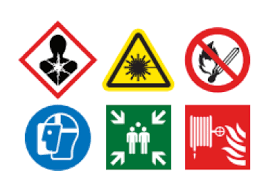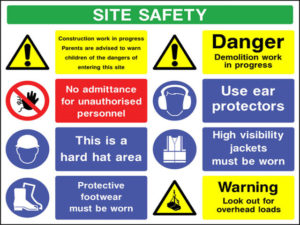[/vc_c
Literacy is the ability to read, write and understand a particular language or type of information. More broadly, it is to have a level of competency in a particular area i.e. computer literacy. There are many, different and recognized literacies. Each literacy comprises its own unique set of symbols and terminology: Language literacy (a, b, c, ?!&, words), Numeracy (1, 2, 3, + – = calculator), Computer, or Digital, literacy (@ / _ modem) Financial literacy ($ £ % money), Musical literacy, Geographical literacy, Media literacy and so on. A person must have the necessary level of subject literacy skills needed to navigate a subject area and thus be viewed as competent in that field.
Occupational Safety and Health (OSH) information is designed to keep us safe and healthy. As with other literacies, OSH uses a its own unique communication system composed of different shapes, colors, symbols, pictograms and jargon. These have been designated by the International Standards Organization (ISO) and are universally accepted and used.
OSH literacy can become even more specialized depending on different industry sectors.
OSH literacy has become an essential life-skill literacy. We can see examples of it everywhere: at home and in public places too.
There are hard and soft OSH literacy skills such as being able to use a piece of OSH equipment (fire extinguisher, PPE) communicating effectively and working with others. There are also OSH numeracy skills e.g. assessing risk and using weights and measures.
OSH literacy ability levels can be mapped to competency matrixes from entry-level to advanced and it involves a continuum of life-long learning. It empowers vulnerable groups to be aware of their rights and how to seek help. Indeed OSH literacy fulfils all the criteria to be recognized, and taught, as an essential life-skill literacy. However, this has not happened, yet. As a result, globally the vast majority of young people continue to leave education and enter into employment, training and independent living without any of the functional OSH literacy skills needed to identify, access, utilize or comply with any of the OSH information and services they are likely to encounter, or need – even though these OSH information and services have been designed specifically to help keep them and others safe! Nor do they have any other OSH literacy competencies.
In addition to the lack of education and training, there are many other factors which can restrict a person’s ability to learn, access and use OSH information and services such as: cognitive, (learning difficulties), physical (poor eye-sight or hearing) and linguistic (OSH uses a lot of specialized terminology e.g. COSHH, PPE which is not taught a part of any general language programme NB: English (a notoriously difficult language to read) is the lingua-franca used in the international workplace and in OSH). Age, gender, social, cultural, economic and even religious factors can also play a role. Unfortunately, already at-risk groups tend to find employment in high-risk, often unregulated, industries such as: agriculture, construction, waste collection and recycling. There are also remote, part-time, seasonal, gig-economy and black-economy workers to consider.
To compound the problem, in this Age-of-Information we are constantly bombarded with a vast amount of different coloured signs, symbols , advertisements and icons promoting a wide-range of products and services. These can be very confusing. Many people, especially those groups already mentioned, do not have the OSH literacy skills needed to identify, differentiate and prioritize these. In fact, many of us have actually become totally oblivious to them.
OSH literacy skills are essential to your physical, mental, social and economic well-being. It is a skill that cannot be learned experientially. Unlike other literacies, there is no room for confusion or mistakes. As the statistical data shows, you rarely get a second chance if you make a mistake due to poor OSH literacy skills. You must get it right first time and all the time.
‘Every 15 seconds a worker dies from a work-related accident or disease. Every 15 seconds 153 workers have a work-related accident.
Data analysis shows that poor communications and human factors are a root-causal factor in a significantly high number of all recorded OSH incidents globally. The highest-risk group are those within their first twelve (12) months of employment. Some estimates suggest that more than 50 % of all recorded global OSH incidents are within this demographic. There is no data currently available to show the amounts of deaths, diseases, injuries and losses which occur in the home or in public places due to a lack of OSH literacy skills.
Nevertheless, all available statistical-data suggests that there is a strong correlation between the amount of people entering into new workplaces with little or no OSH literacy skills and the alarmingly high numbers of people who have OSH related incidents within their first twelve (12) months of employment.
International and national legislation such as the U.N. Convention on Human Rights and The Equality Act oblige employers to make workplaces more inclusive. The same laws, as well as others, also oblige employers to ensure that their OSH information and training is understood by ALL their employees. However, persons with a responsibility for workplace safety and health communications and training seldom have the experience, expertise, time or resources needed to adapt their language and materials to make them accessible for at-risk employees with little or no OSH literacy skills.
Over the years there have been, and there continues to be, numerous, expensive national and international initiatives and declarations (Lisbon, Rome, Berlin etc.) to tackle the high level of workplace deaths, diseases and losses which occur globally. However, these have had a limited impact on the statistics. primarily because the end-users do not have the basic OSH literacy skills needed to engage with these initiatives. As Shakespeare said: ‘ It’s all Greek to me’.
For many years there have been calls by business, as well as other international and national bodies, for school curricula to be more aligned with employers’ and society’s needs. All stakeholders have a duty-of-care to work collaboratively, to calibrate learning and employment needs and to ensure that young people, and other high-risk groups, are equipped with at least some basic, functional OSH literacy skills and awareness prior to them encountering OSH information and instruction in work, training and/or independent living.
As the statistical data demonstrates, we must do more to help these vulnerable groups to safely and successfully transition into employment and adulthood. We cannot simply continue to assume, or hope, that already at-risk persons will somehow be able to identify, decode, utilize and comply with OSH communications and training without any prior education or experience relating to it.
There is no need to ‘reinvent the wheel’ either. We can simply use the successful system used to teach other literacies. They follow a tried and tested model of firstly giving learners a foundation literacy level in a subject area. This is then built upon. Teachers and students are familiar and comfortable with this model of learning.
Over several years, OSH literacy has initiated numerous international outreach projects. These have all demonstrated that pre-teaching basic OSH literacy skills greatly increases a person’s ability to understand, engage and comply with OSH information and training. Thus decreasing the likelihood that they will have an accident due to poor communications. Furthermore, employers appreciate potential employees with basic OSH literacy abilities. Having OSH literacy skills and certification greatly enhances an individual’s long-term health and wellbeing prospects as well as their social and economic mobility. In addition, teaching OSH literacy in the safety of a classroom allows for individuals, who may have difficulty with this literacy, to be identified early so that remedial actions can be taken to safeguard them and others from potential harm and losses. Basic OSH literacy training can also provide a strong foundation for life-long learning and persons who have gained OSH literacy skills can cascade these skills and knowledge within their families and communities.
OSH literacy is linked to the United Nations’ ”’Social Development Goals”’ (UN SDGs) 2030, in particular SDGs: 3, 4, 5, and 8. In June 2022, the International Labour Conference added Safety and Health to its Fundamental Principles and Rights at Work. The landmark decision means that all ILO member states (The ILO has 187 state members. 186 of the 193 member states of the United Nations plus the Cook Islands) commit to respect and promote the fundamental right to a safe and healthy working environment, whether or not they have ratified the relevant Conventions. Therefore, there is a strong case for OSH literacy education to be regarded as a fundamental right and that it should be taught to individuals prior to them encountering OSH communications in work, public spaces and independent living situations.
We also train trainers and others with a responsibility for workplace safety and health information, on how to make their OSH communications and training more effective and inclusive. For employers and safety representatives, to have an awareness of OSH literacy levels and barriers, allows them to comply with their legal and moral responsibilities. There are also other practical and economic benefits.
We at OSH literacy firmly believe and advocate that it is common-sense and good-practice to recognize and teach OSH literacy as an essential, life-skill literacy. This can provide a simple solution to make current and future education to employment ecosystems (and current OSH communications) safer and more cohesive. It would also provide a tangible, life-long educational, economic, social, safety and health benefit to very many people.
Thank you for taking the time to read this information. I hope it has been of interest to you. Should you require any further information or advice regarding OSH literacy, please do not hesitate to contact me or any member of our team.
Yours,
Dave Magee. (Founder) contact me: davidmagee@oshliteracy.org
* Adapted from Kim Rauscher and Doug Myers (2014)
Please note: The Images used in this article are for educational purposes. Several have been taken from the internet. We have tried to contact all those who claim ownership. In some cases this has not been possible. For further details, please contact us.
NB: OSH literacy is only a small part of a much larger movement to have OSH mainstreamed into education systems. The European Network for Education and Training of Occupational Safety and Health (ENETOSH.net) was started in 2005 by Dr. Ulrike Bollman, a world renown educational scientist. Based in Germany, the network now has nearly 100 institutional members from 38 different European countries. In addition, there are affiliates from all over the world. It is a highly respected international organization. All of the world’s major Safety & Health organizations support the network’s primary goal of having Safety & Health mainstreamed into educational systems from kinder-garden through to university and life-long learning. Individual and Institutional membership is open to all non-profit organizations and the membership fees are optional. There are nearly 1000 examples of best practice in its freely available database and membership gives like-minded people, educational establishments and other organizations the opportunity to network and work together to achieve our common goal. Please take a moment to have a look at the website: www.enetosh.net and join this progressive movement as either an individual or institutional member.
[/vc_col
[/vc_col
[/vc_col
[/vc_col
[/vc_col
[/vc_col
[/vc_col
[/vc_col
[partners_carousel_sc to_show=”9″ category=”all” scroll=”yes”]
[/vc_col



























